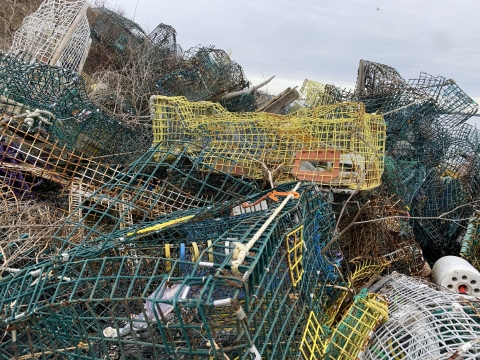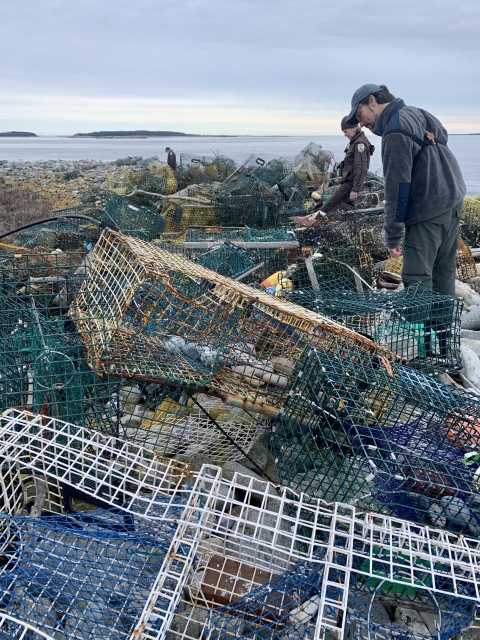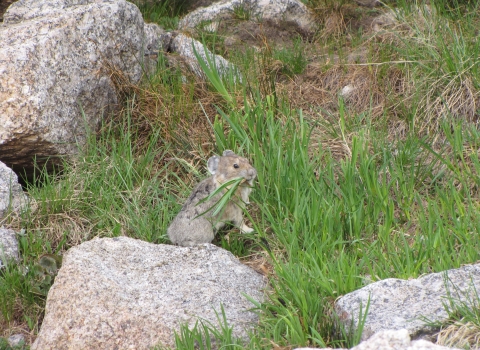About an hour off the coast of Maine lie some of the state’s most unique environments: tiny sea islands that are often little more than piles of rocks with shrubs growing in the middle. They’re largely uninhabited, save for colonies of nesting seabirds. Yet even these remote patches of wild are not immune to the pervasive hand of human influence.
Even before we reach shore, I see it: hundreds of lobster traps, buoys, and ropes melded into mountains three or four feet high.
“That’s not even half of it. The other side is so much worse. This looks good compared to the rest,” Michael Langlois, fish and wildlife biologist at Maine Coastal Islands National Wildlife Refuge (MCINWR), tells me as I climb out of the motorboat into the small dingy that we’ll take to shore on Hart Island.
He’s right. Once on the stout little island, the extent of debris is evident in ways no number of interviews or photographs could convey. The traps are not merely stacked on top of one another, but rather battered and broken, so the wires of one trap weave into the next, building a massive mesh of continuous metal grid. Drop lines thread through the tangled mess, and trap weights hold down the already-heavy wire pots.
This is the scene all the way around the quarter-mile curve of the island’s windward side. The island has begun to grow around this collection: rocks line the inside of the traps; grass and twigs poke through and around them; and, most tragically of all, seabirds build their nests within them. When I visited in early April, I saw the lingering skeletons of birds who had died in the traps the year before.
Connecting birds and debris on our coast
These birds, or at least what remains of them, are the reason I came here in the first place. I tagged along with a team from the U.S. Fish and Wildlife Service’s Northeast Region Migratory Birds Program who, with a robust network of partners, are addressing marine debris’ effects on birds in the Gulf of Maine. They’re raising the alarm – and gathering evidence – on this intersection for the first time in the region.
In April 2022, the Service and partners published a report, “Identifying and Addressing the Impacts of Marine Debris on Birds in the Gulf of Maine Region,” examining the threats marine debris—like the forgotten lobster traps on Hart Island — presents to birds in the gulf, which extends from Canada to Cape Cod.
In 2019, the National Oceanic and Atmospheric Administration (NOAA) Marine Debris program published a Gulf of Maine Marine Debris Action Plan, which identified a need for more research on the interactions of marine debris and wildlife. In partnership with NOAA and with support from the National Marine Sanctuary Foundation, the Service’s report answers NOAA’s call for more research into debris’ effects on birds.
North America has lost over three billion birds – that's nearly a 30% decline in population -- over the past 50 years. Shorebirds represent one of the five groups of birds that have experienced such precipitous declines. The Service is prioritizing research into what is causing those deaths and how to stop them.
“Everyone sees the debris, but the connection to birds has not been made as strongly on this coast,” said Caleb Spiegel, one of the report’s lead authors and a wildlife biologist in the Service’s Migratory Birds Program.
In its first section, the report does just that. With information collected through scientific literature review and stakeholder interviews, the authors synthesize what is known about Gulf of Maine marine debris in three categories: the types of debris, the harms this debris causes birds, and strategies for reducing the trash. It also highlights what is still not known about marine debris and areas for future research.
The findings give context to some of what I saw at Maine Coastal Islands Refuge – and what the staff there has been seeing for years. The authors found that, all across the Gulf of Maine, birds experience the harms of marine debris in three main ways: ingestion, nesting habitat degradation, and entanglement and entrapment.
Before the nesting season even began, our group saw 10 dead birds and evidence of each of these interactions. Styrofoam buoys were pockmarked from gulls pecking at the apparent snack. The report highlights predictions from recent models that suggest 99% of seabird species and 95% of individual seabirds will have ingested some plastic by 2050.
On Hart Island, trash mixed with twigs and grass appeared to be the building material of choice in the remaining nests. One bird had backed its nest under the curving overhang of a mangled lobster trap -- “It’s like a little carport,” joked Linda Welch, wildlife biologist at the refuge.
Many of the dead birds were victims of entrapment, their carcasses stuck in a wayward lobster trap they would never leave.
Welch demonstrated how a baby bird could easily make its way through the square-inch gaps between wires on a lobster trap. “We think the chicks are hiding in the traps when they’re little, and then look – the parent can come and feed them through the gaps, without the chick having to leave. Then they grow, and they can’t get back out. They get stuck in there,” she said.
“Just how do we get rid of all this?” Welch repeated over and over as we walked around the curve, I think only half-looking for answers, half simply underscoring the scale of the problem.
Getting debris off our coast
The report asks that same question and builds a map to begin answering it. The implementation framework activates the network of government agencies, fishing industry professionals, and nonprofit organizations working in overlapping fields (“the partners”), that contributed information and observations for the report. Rather than let this network dissipate post-report, Speigel realized the value in using the same group to develop “more boots-on-the-ground strategies.”
The report includes an appendix with partner names, contact information, responsibilities and deadlines. “That's what's lacking a lot of times in this field besides funding -- accountability, right?” said Michael Andranovich, who wrote most of the report with Speigel, in completion of his master's degree at University of Rhode Island. “A lot of people have a lot of great ideas, but they don't always have the push to get started.”
The implementation framework targets ways the network of partners can fill information gaps related to the marine debris problem. It also outlines ways partners can work together to reduce waste by addressing derelict fishing gear, reducing consumer litter, and engaging community scientists.
The challenge of engaging scientists, community or otherwise, was on Meg Harrington’s mind as we surveyed the circumference of Hart Island. Now a Service biologist, Harrington was a Fish and Wildlife Fellow with Spiegel and the Migratory Birds team, guiding the implementation framework.
When we were in Maine, Harrington was putting the finishing touches on the framework’s first product: a survey form to collect debris data from people on the ground. There will be a version for conservation professionals and another for community members and beachgoers. The first version is in Beta testing with a partner group that focuses on fishing gear and bird impacts. It aims to fill crucial information gaps about where marine debris is most prominent, what kind people encounter, and how much there is.
“But how do you quantify this, when it’s the whole island?” Welch asked.
As we walked, Harrington brainstormed answers aloud and posed some of her own questions in return – after all, how do you quantify a problem like this, when a single discarded plastic straw and a lost, bulky, and mangled lobster trap each count as one piece of litter?
The form gives options, asking the survey-taker to include a photo and a qualitative judgement on how much of the beach is covered by trash, with low being less than 1% and high more than 10%. Observers can include details, including the type, count, dimensions, or weight of the cumulative debris.
"I found the visit to Hart Island to be really, really eye-opening,” Harrington said. "Finding the 10 bird skeletons and hearing the stories about chicks being found inside the traps was heartbreaking. We have a lot of work to do. I'm more motivated than ever to help raise awareness about the issue and find solutions that work for the birds, biologists, fishers, and concerned members of the public alike.”
Finding hope to move forward
Harrington’s sense of heartbreak was not hers alone; it is daunting to stand on Hart Island and survey the scale of the problem, knowing the casualties it brings wildlife.
“These islands are owned by the public, and we are entrusted with managing them and trying to protect the habitat, and it’s hard to feel like you’re doing a good job when they’re covered in debris. And then that’s even more challenging when you find dead birds in them, and you know that’s going to happen every single year as long as all those traps are on the island,” said Welch.
But, for the first time, the concrete framework of solutions, the broader awareness of the issue, and the robust network of partners united around this shared problem are all offering a fresh balm to some of that hopelessness.
“Efforts like this [report] are really valuable for bringing partners together. Sharing knowledge and communicating new information between organizations is a really important way to work towards solutions on marine debris problems. Anything that we can do to better share information is always a good step forward,” said Demi Fox, the Northeast Regional Coordinator for NOAA’s Marine Debris Program.
Laura Ludwig is something of an old pro when it comes to tackling problems of marine debris. She works at the Center for Coastal Studies in Provincetown, Massachusetts and formerly ran lobster gear clean-up projects for the Gulf of Maine Lobster Foundation. It’s hard to miss the optimism in her voice when she talks about the partnership she’s become a part of through the work of this report.
“I’m really excited about [the partnership] because it allows me to have a little toolkit, so that anytime I have any questions or observations that I want to run by people who have more information than I do, I now have that roster," she said. “The reality is we all share in the problem, and we all share in the solution.”
“People began to realize there’s a heck of a lot more going on out there [in the Gulf of Maine] ‘cause we’re now all convening and sharing information,” Ludwig added. Sharing this information, making the situation known, is half the battle when it comes to engaging community members, legislators, and industry.
“It's clear that we need to pull together and do what we can to help [on the issue of marine debris],” said Speigel. “Birds face so many threats right now. Marine debris is overwhelming but at least somewhat tangible; maybe more than some other threats like climate change climate change
Climate change includes both global warming driven by human-induced emissions of greenhouse gases and the resulting large-scale shifts in weather patterns. Though there have been previous periods of climatic change, since the mid-20th century humans have had an unprecedented impact on Earth's climate system and caused change on a global scale.
Learn more about climate change . We know what the issue is and broadly what needs to be done about it. The challenge is getting enough people to work together: to keep trash out of the oceans we rely on, to understand what it's doing to birds and other wildlife, to focus on clean-up efforts.”
Right now, the primary goals of this stage of implementation are to better understand the extent of impacts, prioritize areas for clean-up and prevention, and highlight the problems for legislators, industry, and public.
Spiegel, Harrington, and Andranovich have been spreading word of their work and proposed solutions across the region, sharing findings of the report, presenting vivid photos of Hart Island, and offering tangible items from the solutions framework that individuals can do right now: things like joining local beach cleanups, cutting down individual plastic waste, and helping close the crucial information gaps by filling out trash surveys when they encounter marine debris.
“You could be a child; you could be an adult; you could be a senior citizen. You could be a research scientist; you could be a wildlife scientist, a plastic scientist. We tried to make it as inclusive as we could with these different strategies,” Andranovich said.
As Speigel and the Gulf of Maine partners forge ahead into summer nesting season – also the time of beachgoers, seaside bonfires, left-behind beer cans and snack wrappers, and forgotten flip flops – it's obvious the issue of marine debris is not an individual problem but a communal one. They’ll keep collaborating to fill the information gaps and ticking off the laundry list of work to be done from that implementation framework. This is only the beginning when it comes to tackling the harms of waste that often feels never ending.






